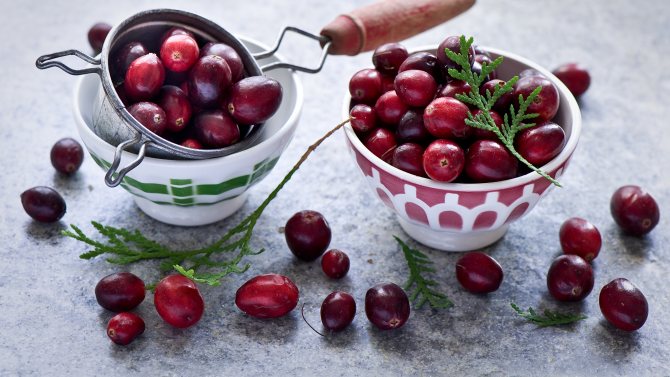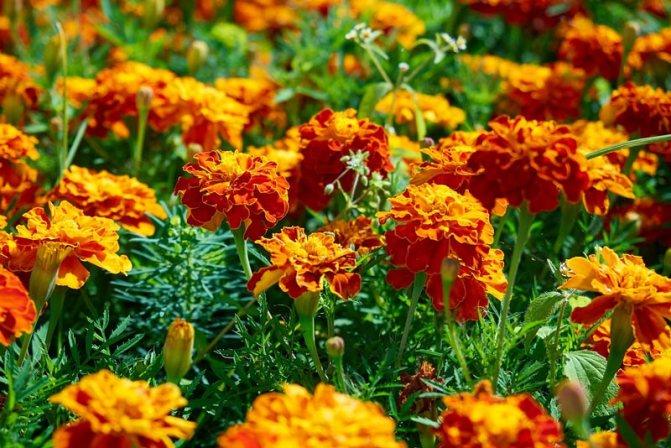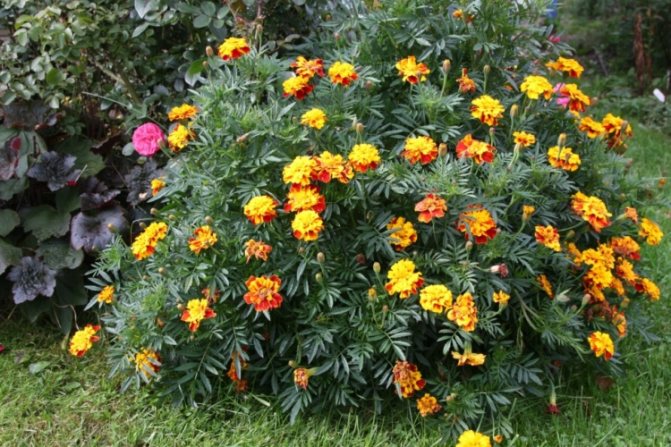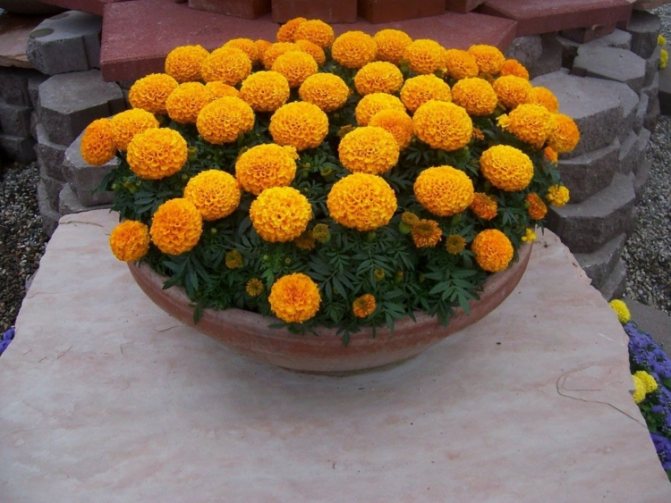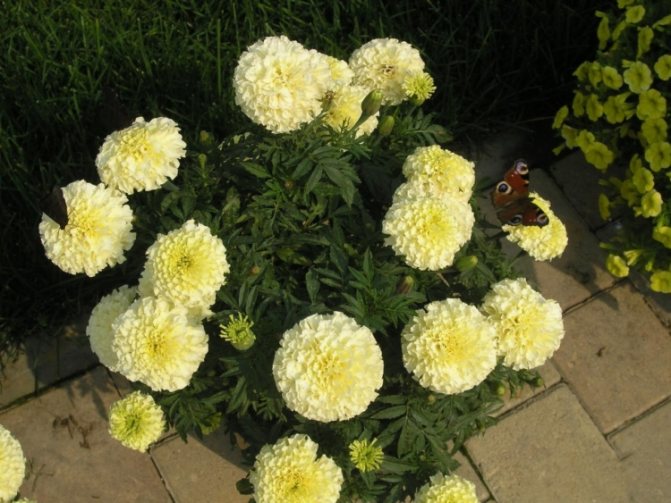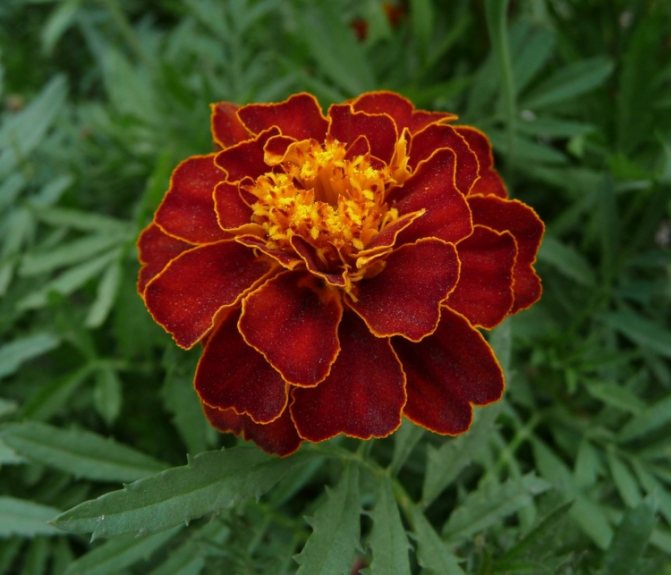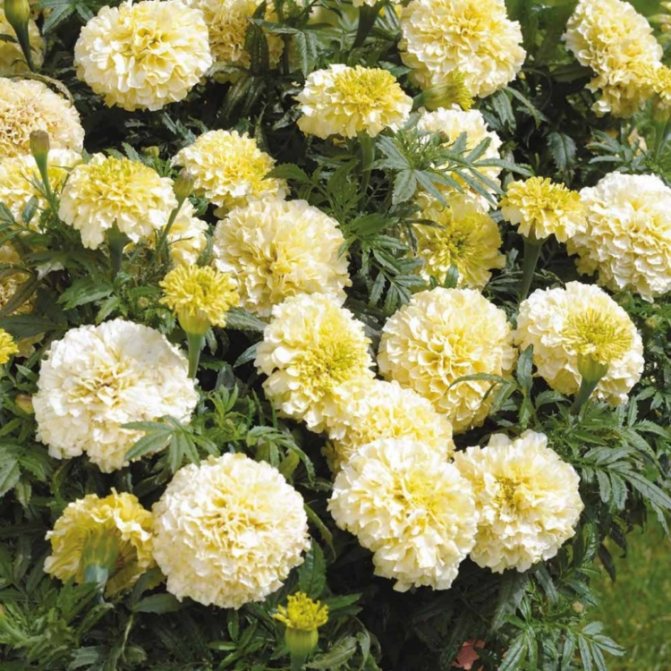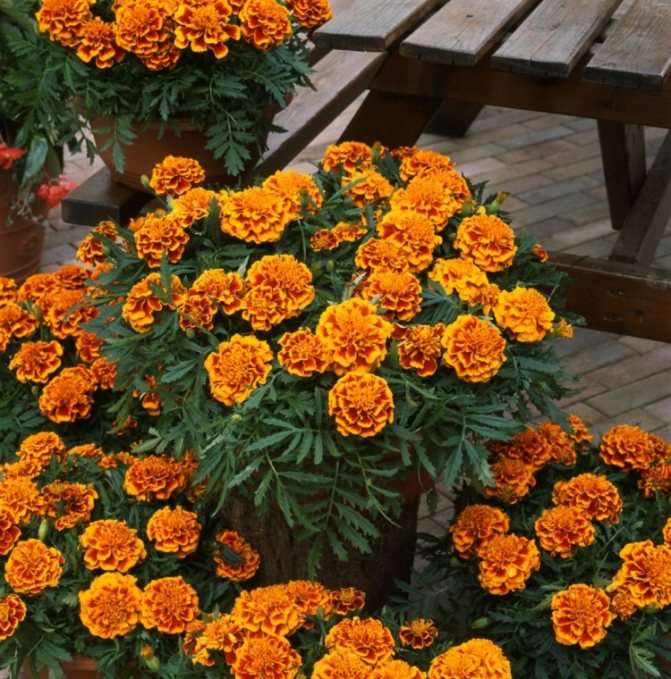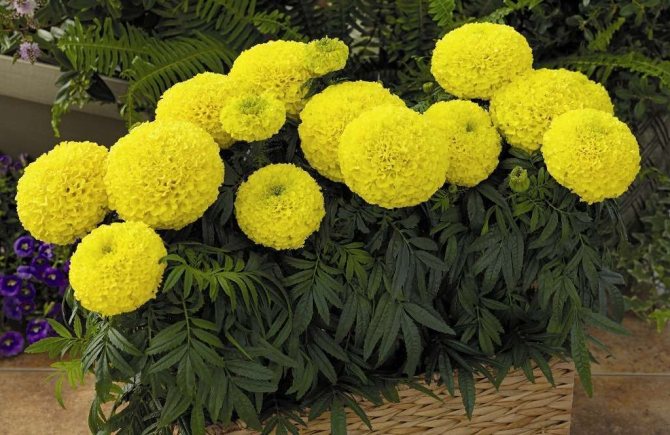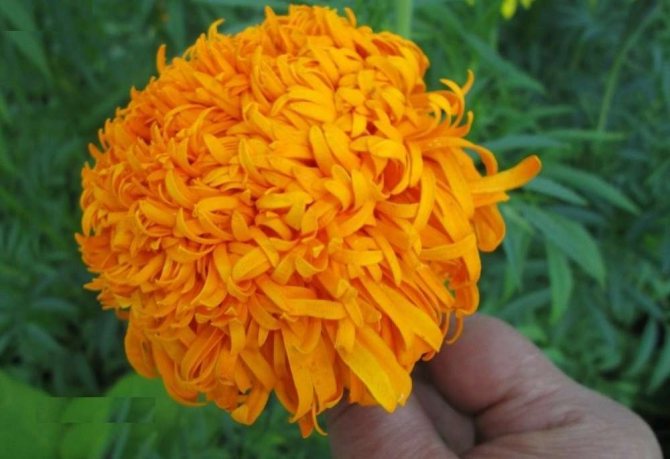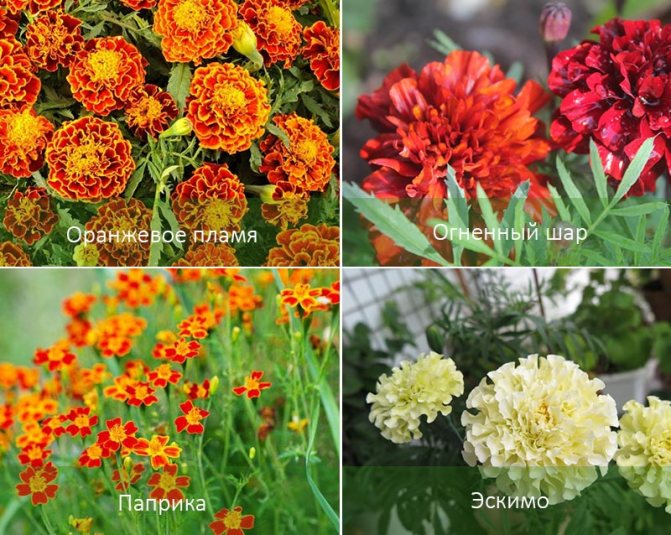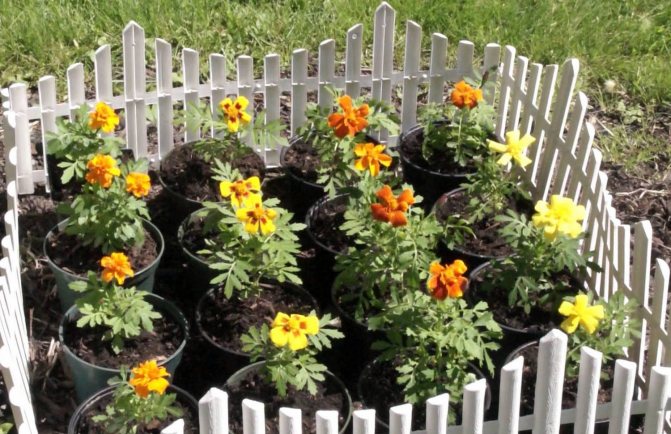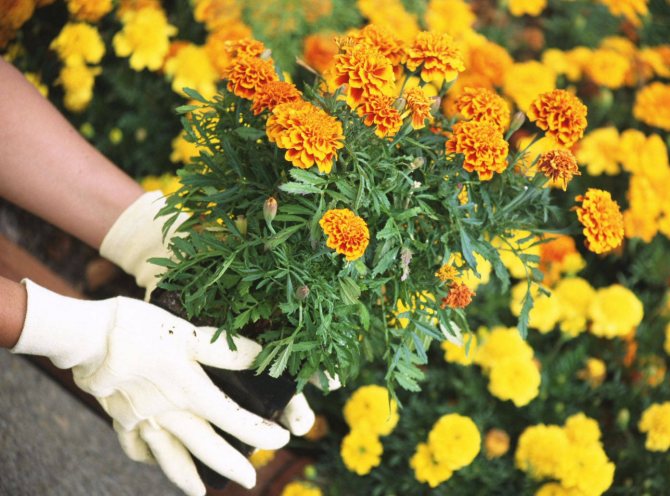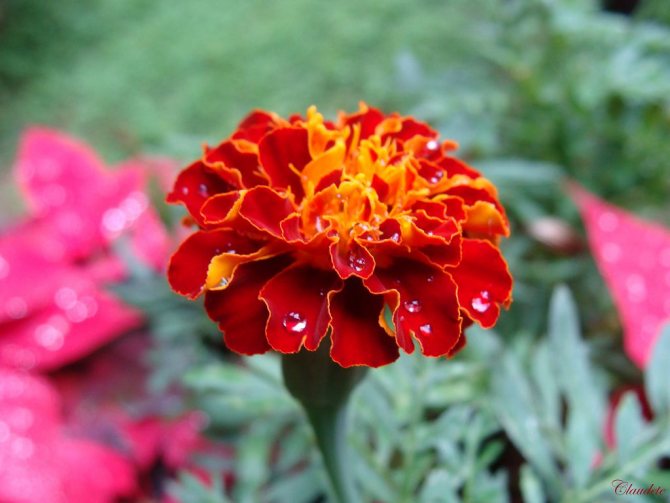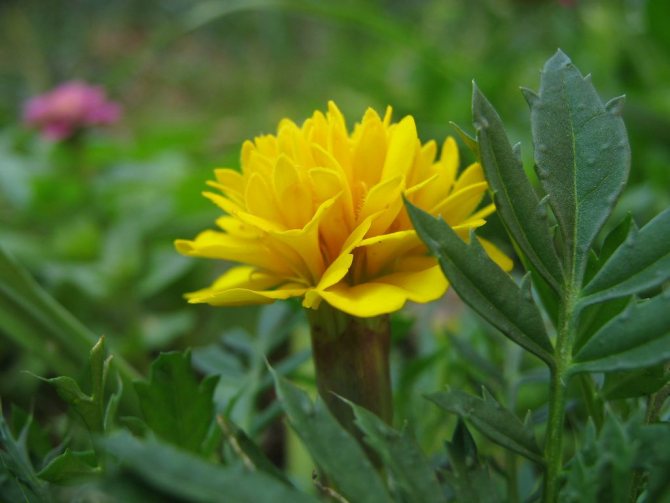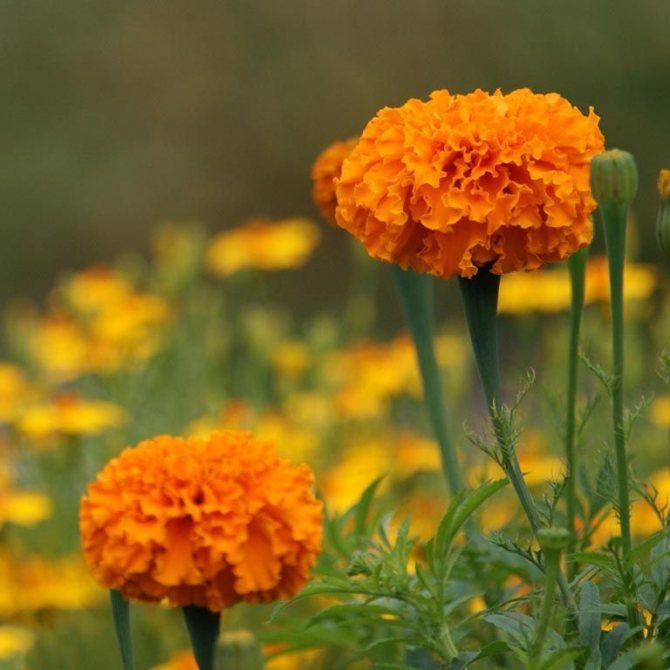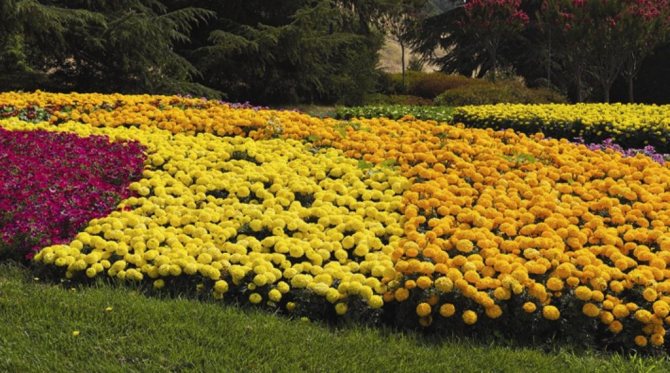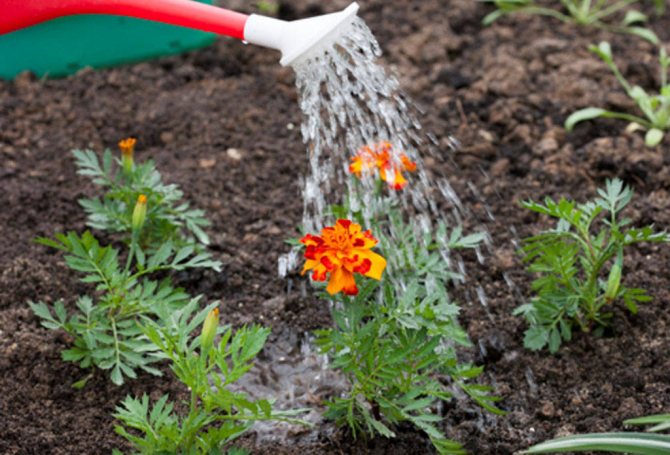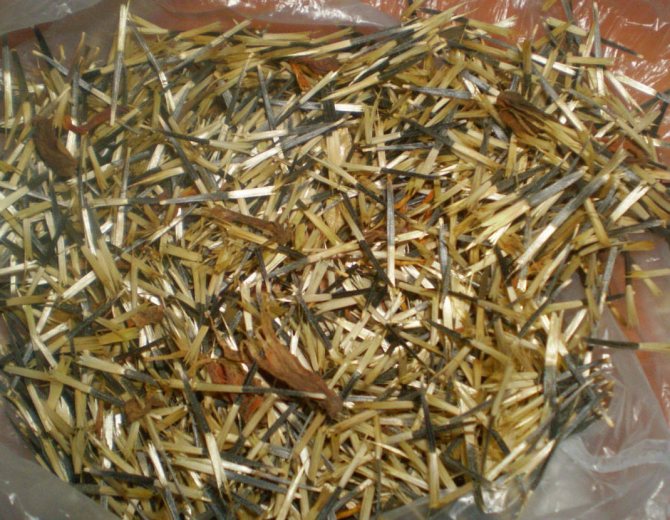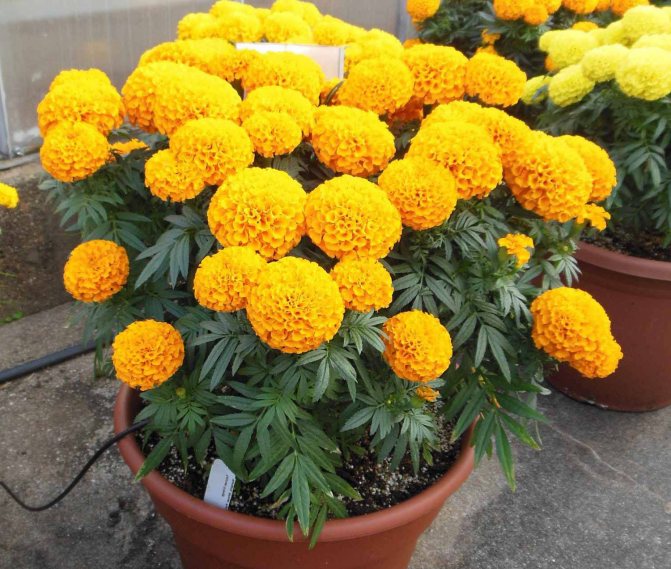- Marigolds rejected
- Marigolds erect
- Distinctive features of rejected and erect marigolds
- Rejected marigolds: flower shapes
- Summing up
Surely, you have ever met these plants and seen how the decor of landscaping the streets of your city. Unpretentious to care and weather conditions, rejected marigolds and erect marigolds often become the choice of gardeners. This flower is divided into several types, and the number of varieties has already exceeded a hundred and the number is rapidly growing upwards. Let's talk about some of them and the differences that deviate from the upright ones.
Features of marigolds
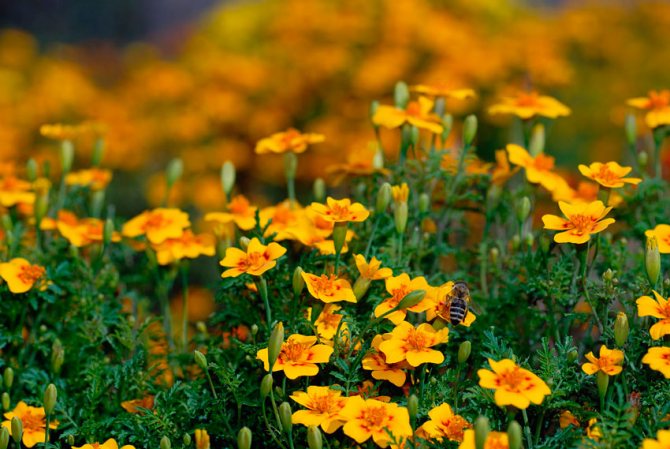
Branched or erect shoots form a bush 20–130 centimeters high. Fibrous root system, there are pinnately dissected or pinnately divided leaf plates, which are alternately or oppositely located. The color of the leaf plates is from dark to pale green. Flower baskets can be painted in a variety of shades of brown, yellow and orange. The marginal flowers are pseudo-ligate, and the median ones are bisexual, tubular, there are 5 stamens. The pistils have a pair of stigmas, and the ovary is lower. Abundant flowering, begins in the first days of June, and ends with the onset of the first frost. The fruit is a linear achene. These plants are capable of producing abundant self-seeding. At the same time, seed germination can persist for 3 to 4 years. The plants give off a strong, spicy aroma, with the leaf blades smelling much stronger than the flowers.
Marigolds and landscaping
You can plant marigolds almost anywhere, except near water bodies and in thick shade. Depending on the shape of the bush (spherical, compact, inverted pyramid) and the height of the stems (20-120 cm), try to plant the shortest along the edges of the borders, and the taller ones closer to the center of the flower bed so that all flowers are clearly visible in the flower garden. According to the color palette, the flower bed can be almost monochromatic (for example, all shades are yellow-golden) or contrasting (red-white, brown-yellow). From summer to autumn, the flowers will not lose their decorative effect, because the dried inflorescences will hide under the blossoming ones. A common problem for all lovers is to plant the site to the maximum with their favorite vegetables and fruits, and so that there is enough space for flowers. So, marigolds can be planted around the perimeter even beds with potatoes or any other vegetables. It will be cute and fun!
Properties of marigolds
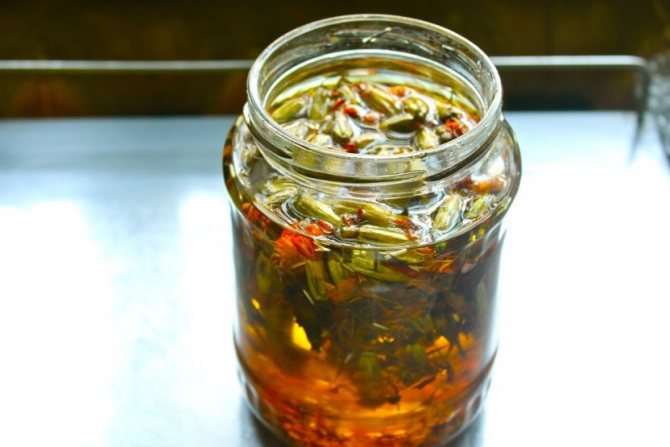

Marigolds have long been used for medicinal purposes. They have been carefully researched by scientists, and they have confirmed that these flowers really have healing properties. In this regard, marigolds can not only decorate your garden, but also heal various diseases. So, the lutein contained in them will help to avoid the development of cataracts. This plant is also able to help with inflammation of the pancreas, as well as diabetes. An infusion made from dried marigolds is used in the treatment of bronchitis, colds, stomatitis, asthma, and it also purifies the blood. To make an infusion, you need to mix 1 large spoonful of chopped flowers with 1 liter of freshly boiled water. After 3 hours, the infusion must be filtered. Drink it 200 g 30 minutes before meals for 4 weeks.
With neuroses and depression, experts recommend taking baths, into which a decoction of marigolds is poured, as it helps relieve stress, normalizes the nervous system, and eliminates anxiety. And for a long time, the peoples inhabiting South America have used these plants as food, as well as a seasoning, and also for making marinades, sauces and various pastries. In the Caucasian markets, you can buy marigold powder, which is called "Imeretian saffron", it is seasoned with satsivi, pilaf and soups. In France, these flowers are grown on an industrial scale, as they are in great demand among gourmets. If you put the leaves of such a plant in the marinade, then the vegetables will smell very nice, and they will retain their elasticity for a long time.


You can also make delicious cookies with marigolds. To do this, you need to separate 4 proteins and beat them well to form a foam. Combine 100 grams of granulated sugar with 2 large spoons of fresh flower petals of such a plant and grind everything thoroughly. 4 large tablespoons of cow oil must be continuously rubbed, combined with the remaining yolks, with granulated sugar mixed with marigolds, and with 100 grams of wheat flour. After that, on top of the resulting mass, you need to very carefully lay out the proteins and gently mix everything slowly. Grease a baking sheet with oil and place the dough in it. The cake needs to be baked until fully cooked, until its surface acquires a golden hue. When the resulting cake becomes cold, it must be divided into squares with a knife.
Main types and varieties with photos and names
A large number of different types of marigolds are cultivated by gardeners, but the most popular varieties are only 3 species, namely: rejected (undersized), erect (most often high) and thin-leaved (rarely found in middle latitudes). The varieties of these species are distinguished by their diversity. So, their flowers can be large or small, double or double, and painted in various shades of orange, brown and yellow.
Erect marigolds (Tagetes erecta), or African
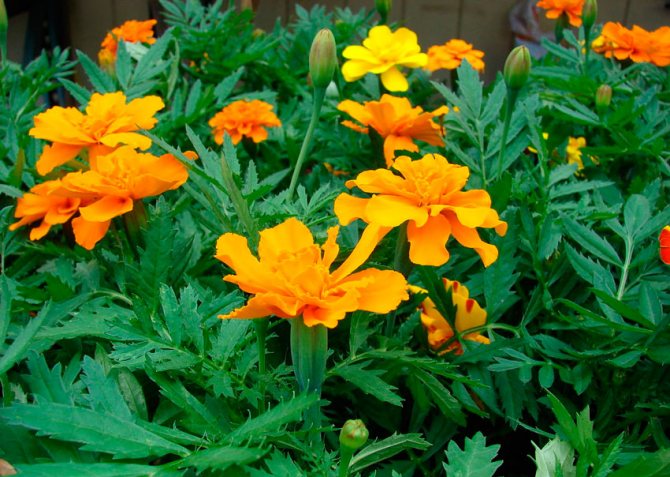

In this genus, they are giants, so their height can reach 0.3–1 meters. Most often, terry inflorescences are painted in one color shade, while their diameter does not exceed 15 centimeters.
Popular varieties:


- Vanilla - the height of the bush is up to 0.7 m, the diameter of the terry white-cream inflorescences reaches 12 centimeters.
- Kilimanjaro - the height of the bush is 0.6–0.7 m, densely double inflorescences have a spherical shape.
- Antigua - undersized variety, the height of the bush is no more than 25 centimeters. The bushes are erect, and they have large (about 15 centimeters in diameter) flowers, painted in a yellow-lemon, deep yellow, golden or orange hue.
Marigolds undersized, or rejected, or French (Tagetes patula)
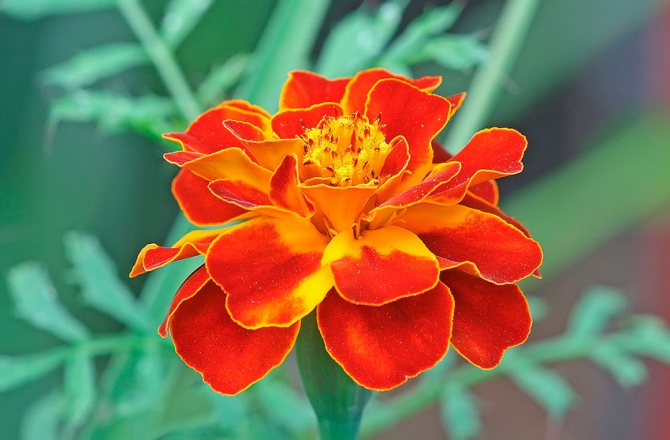

The height of the bushes is most often below 0.6 m. On compact bushes there are a large number of non-double and double inflorescences, the diameter of which is most often no more than 8 centimeters. This type is also called sprawling. The most popular varieties are included in the Bonanza series, the height of which does not exceed 30 centimeters, for example, Bonanza Bolero, Bonanza Orange, Bonanza Flame, etc. Their bushes with terry small (about 5-6 centimeters in diameter) inflorescences painted in saturated colors, look very impressive. Carmen marigolds are also highly decorative. Their inflorescences, which are terry, consist of corrugated petals. The petals in the central part are yellow-orange, and brown-red at the edges.
Tagetes thin-leaved, or Mexican
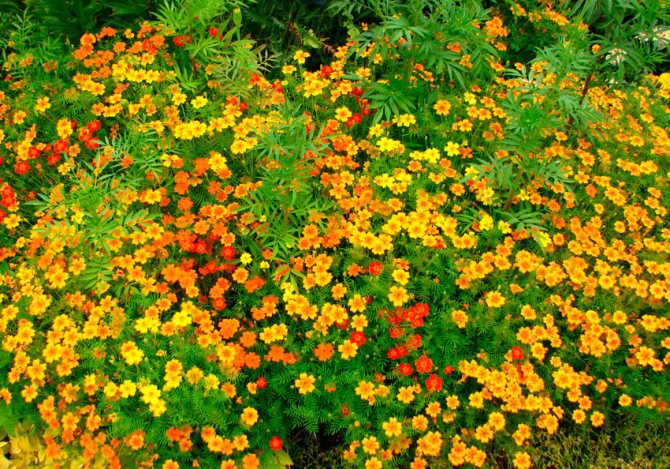

They look very different from other species. So, they have fragrant openwork-lace leaf plates that seem to float in the air.And they also have a huge number of small inflorescences, due to which the effect of sparkling fireworks is created. They can be tinted yellow-gold, orange-red and orange-gold. They have been cultivated since 1795. Today there are about 70 varieties of this species. The height of the bushes does not exceed 40 centimeters. Their root system is very powerful, and there are also adventitious roots at the bottom of the shoots. The most popular varieties are Ursula (orange-golden), Golden Jam, Gnome, Lulu (yellow-golden), Paprika (orange-red).
Erect marigolds (Tagetes erecta L)
Tagetes erect - an annual flower, a small bush, with a clearly visible central process. Stems are very branched, reaching a height of 120 cm, erect, slightly ribbed, stiff at the beginning. The lateral branches are directed upward, forming bushes, resembling an inverted pyramid in shape. Foliage is divided, lanceolate, with sharp parts along the edges. The color range is from light to dark green. Inflorescences are large enough, buds with a diameter of 6 to 14 cm, individual, ordinary, half-double or double, on long, tall peduncles. The flowering period begins from late June to early July. The color palette is monotonous, from pale or rich lemon, yellow, orange to two-ton.
The species are divided by height: huge - more than 90 cm high, tall - from 60 to 90 cm, low ones grow up to 40 cm.
Growing marigolds from seeds
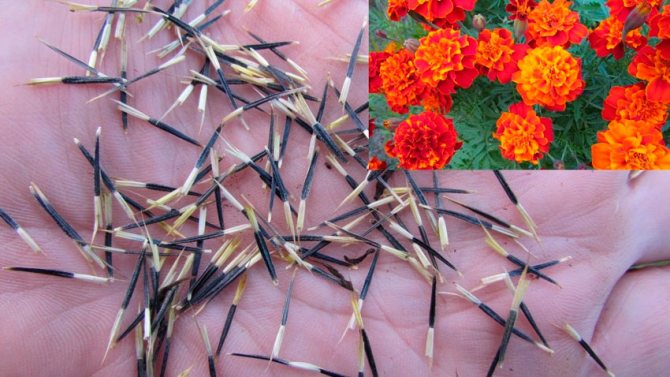

Sowing seeds in open ground
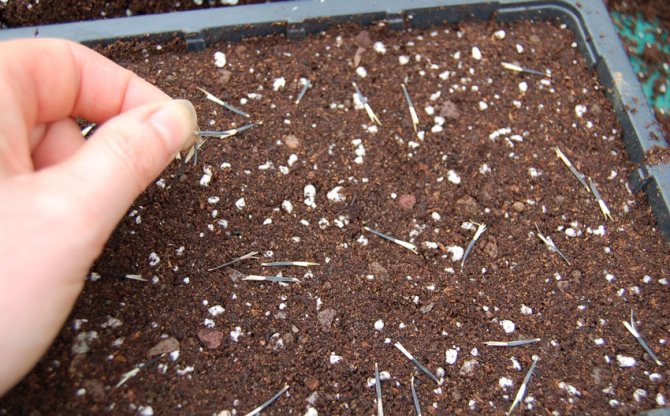

Even a beginner can handle the cultivation of marigolds from seeds. In open ground, you can sow both seeds and plant an already flowering bush. Planting seedlings or sowing seeds should be done after the soil is well warmed up. It is necessary to make a groove with a chopper, which will have a five-centimeter depth. Water it, and then put the seeds in it. After that, the groove must be covered with soil. After half a month, the first seedlings will appear. If the seedlings are too dense, then they need to be planted.
Growing through seedlings
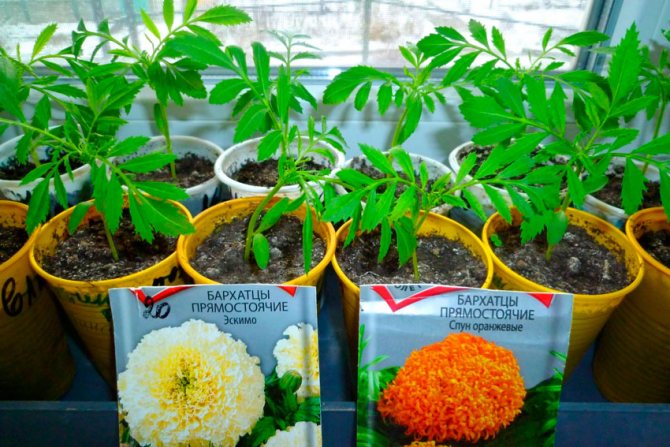

You will have to buy marigold seeds only for the first sowing. The fact is that after the plants you have grown have faded, you will be able to collect a large number of seeds. To do this, wait until the inflorescences are thoroughly dry, and remove the seeds from them on a not rainy day. They should be dried and stored until next spring. However, it should be borne in mind that there are a large number of hybrids on sale, and the seeds collected from such bushes may not retain varietal properties, in this case they inherit the characteristics of any one of the parent plants. Most experienced gardeners prefer to sow seeds that have already sprouted. Cover the bottom of the saucer with a damp cloth and place the seeds on top of it. Then the saucer should be placed in a plastic bag and removed to a warm place. After three days, the seeds will hatch.
At what time to sow seedlings
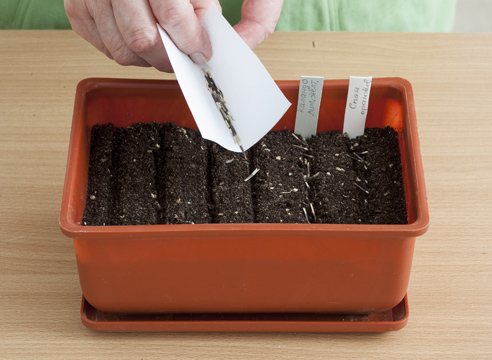

When choosing a sowing date, it should be borne in mind that the earlier you sow the seeds, the faster you will see the flowers. When growing various species, it should be taken into account that small-leaved and low-growing ones are recommended to be sown in the first days of April, and erect ones - in mid-March. In this case, all these bushes will bloom at the same time - in June. It is quite simple to grow seedlings, but still there are several nuances. Prepare a soil mixture, for this combine peat, sand, humus and sod (2: 1: 2: 2). Then it must be disinfected with a solution of a fungicidal agent or potassium manganese (dark pink color). Make a three-centimeter drainage layer of sand, gravel or expanded clay at the bottom of the container. Fertilize the substrate by adding organic fertilizers (fresh manure cannot be used).Make grooves, while the distance between them should be 15–20 mm. Place the seeds in them and cover the grooves with a thin layer of the substrate. Watering must be done very carefully, as the seeds can be easily washed. Place the container in a warm (22 to 25 degrees) and moisturize the soil in a timely manner, without letting it dry out. The first shoots should appear after 7 days, after which the container must be rearranged in a well-lit place in which the air temperature is 15-18 degrees.
What time to plant seedlings
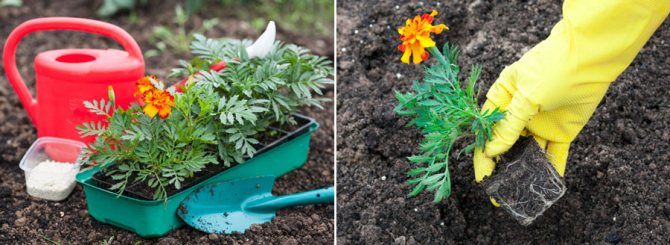

Planting seedlings in open soil is carried out only after there is no threat of frost. Remember that marigolds are afraid of frost. It should also be remembered that planted marigolds should have 3 true leaves, as well as a powerful root system. As a rule, disembarkation takes place in the last days of May, the first in June. For planting, you should choose a site with soil saturated with nutrients, loamy, neutral, which is well moistened from the beginning to mid-summer. In the event that the soil is infertile, then the plants during the period of active growth will need to be fed 2 or 3 times.
The distance between the bushes directly depends on the species and variety. If the plants are undersized, then a distance of 20 centimeters must be observed between the bushes and rows, for medium-sized ones it is 30 centimeters, and for tall ones - 40 centimeters. After the seedlings are planted, they need to be watered often enough and well. Despite the fact that marigolds are resistant to drought, if they are watered rarely and poorly, then the bushes will be puny, and the flowers will be small.
The combination of marigolds with other plants
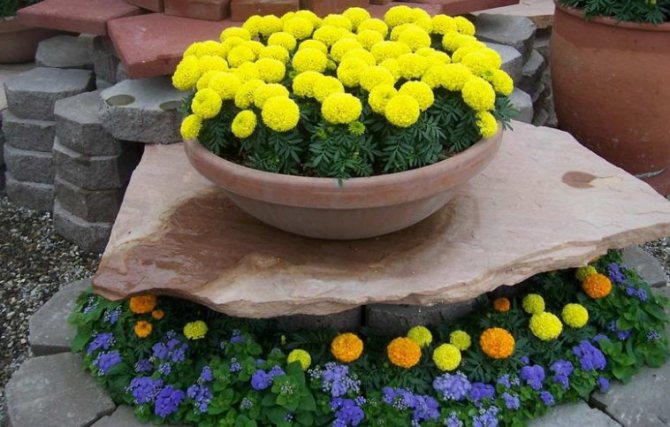

Marigolds are actively used when planting carpet flower beds. In this case, they look great in a company with ageratum, coleus, cineraria, begonia and similar plants. Chernobrivtsi save a young garden, which still has many areas not planted with plants. They are planted in the place of faded bulbous or in places where other plants have wintered.
These flowers look great in flower beds and flower beds, where there is a lack of bright and catchy flowers. These can be places of planting of conifers with a bluish or blue color, purple or bright blue asters.
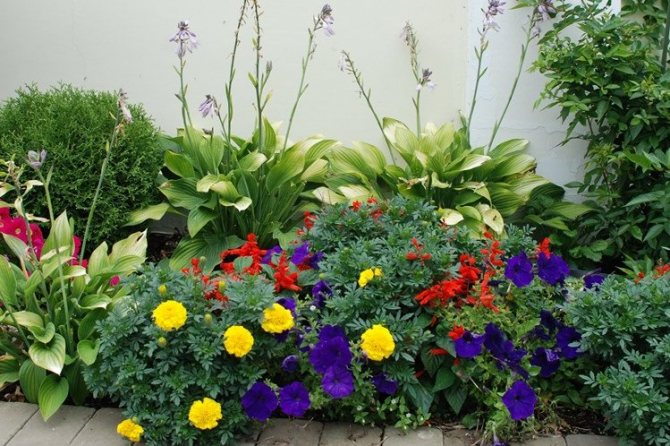

Various varieties of marigolds are also played out in flower beds. So, for example, in the middle of a flower garden with venidium, mallow, amaranth, castor oil plant, cannes, large-flowered black shaves are planted. If the flower garden is formed from medium-sized plants (cineraria, fragrant tobacco, salvia), medium-sized varieties are used, respectively. Low-growing marigolds are planted along the edge of flower beds along with gatsania, begonia, balsam to frame the flower garden.
Marigold care
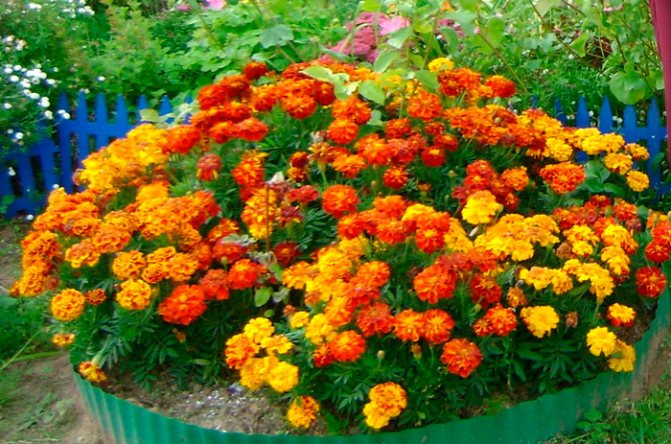

These plants prefer to grow in sunny areas, and it is in such a place that their flowering is most abundant and spectacular. You can also grow such a flower in partial shade and shade. While the flower is actively growing, it should be watered regularly and abundantly, but after the formation of inflorescences begins, watering must be reduced, because otherwise, due to stagnant moisture in the soil, the roots may rot, and this also leads to a lack of flowering. You need to feed marigolds at will, while keep in mind that they respond extremely positively to feeding. For this, a complex fertilizer is used. The first feeding is carried out when the plant reaches ten centimeters in height, the second time - at the beginning of budding, and the third time - when the plant blooms.
These colors need frequent weeding, as well as loosening the soil surface. In the event that the bushes grow in the summer, it will be possible to make a formative pruning. If inflorescences that have begun to fade are removed in time, the abundance of flowering will increase.The strong smell emanating from the plant, as well as the phytoncides included in its composition, protect marigolds, as well as flowers growing in the neighborhood, from fungal diseases. Very often, experienced gardeners plant marigolds along the edge of the entire plot. If a damp rainy summer comes out, then slugs or snails can harm the marigolds. In order to drive away such pests, it is recommended to place jars filled with bleach between the bushes. In rare cases, gray rot may develop on foliage and shoots. Those bushes that are infected must be dug up and burned, as they can infect other plants. If in the summer there are prolonged droughts, then very often a spider mite settles on marigolds. In order to get rid of it, it is recommended to use an infusion of yarrow, onion or red hot pepper. As a preventive measure, in dry times, the bushes must be moistened from a spray bottle several times a day.
Marigold pests and diseases
Due to its specific smell, marigolds are rarely subject to diseases. But prolonged rainy, damp weather can be a good breeding ground for slugs and snails.
They begin to eat the leaves and stems of marigolds. Traps are set to fight them.
| blackleg, | spider mite, | gray rot. |
Humidity is a favorable environment for the development of blackleg. To prevent this from happening, it is important to monitor the condition of the soil. It should not get wet.
The next disease, which leads to an excess of moisture - gray rot.


In dry summers, the plant can attack the spider mite. Onion infusion will help to fight it.
The specific fragrant smell of marigolds and the same aroma of secretions from the roots into the soil are a kind of protection against fusarium and other fungal diseases, not only for the flowers themselves, but also for everything that grows nearby. No wonder the professionals advise to frame almost the entire garden plot with marigolds! Thyme is planted for the same purpose. The healthy look of marigolds depends on care. If it's too dry, a spider mite may appear. With dampness - fungus and rot. In the first case, we correct the situation by watering and spraying, in the second - by drying and heat. When snails and slugs appear, it is better not to use poisonous sprays, since the flowers do not like this. From low temperature, dampness, humidity and thickening of plantings on the stems and leaves, dark brown wet spots may appear - gray rot. Destroy the affected plants immediately before they infect healthy ones. It is noteworthy that if you bury frozen marigolds in a compost heap, then no midges and other harmful creatures will start in it.
Marigolds after flowering
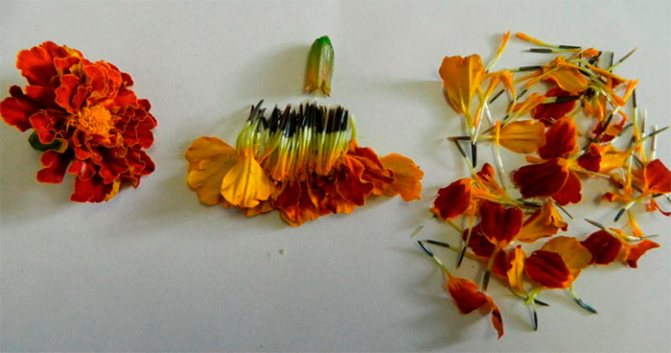

Decorative marigolds are most often annuals. In this regard, after the end of flowering, they must be pulled out. In order to enjoy the beauty of marigolds for the next year, it is necessary to collect ripe seeds in time.
Dry inflorescences can be used both on the farm and for medicinal purposes. For example, if you work at a computer for a long time, it is recommended that each time before eating, eat 2 or 3 small heads of such a flower, and they can also be added to a salad.
If there are pinworms or roundworms, it is necessary to eat several heads of marigolds for 7 days in the evening (for children - 2 or 3 pieces, for adults 5 pieces each).
To get rid of midges flying near the compost pit, pour a full bucket of dried marigolds into it.
If a bouquet of marigolds is placed on the window located near the front door, then guests with ill intentions will pass by.
Healthy recipes
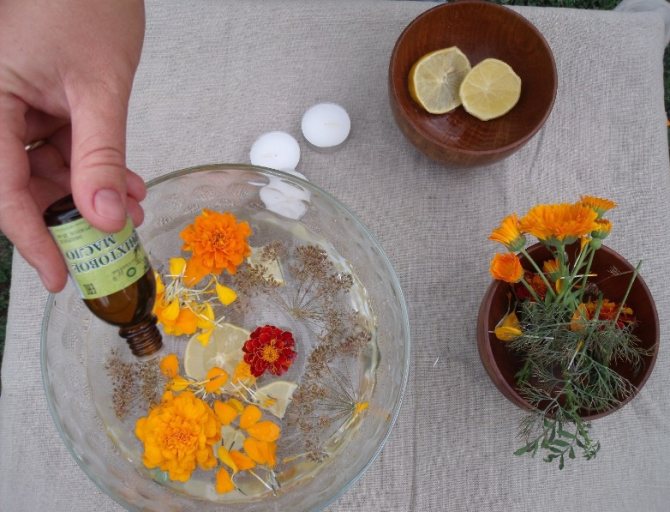

- Lip balmto make it softer. Grind the heads of such a plant and take 2 large spoons of the resulting raw material. Combine them with 1 large spoonful of apricot oil and a third cup of olive oil. Move the mixture to a shaded area for 7 days.After that, it must be filtered, and do not forget to squeeze the marigolds thoroughly. The resulting product should be smeared on the skin of the lips, if necessary.
- Facial lotion... Take a couple of large spoons of crushed plant heads and mix them with 200 g of freshly boiled water. Let stand overnight. Then the infusion must be filtered, while squeezing the marigolds. Pour into the resulting infusion 1 small spoonful of lemon juice and 1 large spoonful of vodka. For storage, the product must be placed on the shelf of the refrigerator. Wipe your face 3 times a day.
- A remedy for prickly heat, for irritation or inflammation of the epidermis of the face. Take a couple of large spoons of chopped marigold inflorescences and mix them with 300 g of hot water. Let the mixture boil, cover and leave for about 3-4 hours. Strain the broth, while squeezing out the flowers. Add a couple large tablespoons of water and the juice squeezed out of a large aloe leaf. For storage, the product must be placed on the shelf of the refrigerator. They need to process the inflamed places 2 times a day.
When to plant marigolds in open ground
Tagetes can be planted in two ways: seeds in open beds and seedlings. Depending on the choice of the method, the sowing time is shifted:
- For seedlings. The seeds are sown in pots from mid-March to early April. Early seedlings when moving to a permanent place begin to bloom in late spring and early summer.
- Seeds in the ground. Not earlier than the second half of April - early May. Wait for the soil to warm up properly. Plants will bloom 1-1.5 months later than those grown by seedlings.
Some gardeners also use this approach: they sow the seeds of marigolds in open flower beds before winter - after the spring snow melts, the first shoots of flowers are already hatching.
By region
When choosing the time to sow seeds for seedlings, take into account the peculiarities of the climate of your area. Marigolds are ready for moving to a permanent place in
1.5-2 months of age. By this time they give their first flowers. Therefore, the threat of recurrent frosts should be avoided by the transplant. In most Russian regions, this is only mid-May-early June. If you are in a hurry, flowers will need protection from non-woven fabric for the first time.
When the climate in your area is mild, warm, you can experiment with sowing marigolds early. Seeds for seedlings are planted in February. In conditions of short daylight hours, the sprouts need additional lighting with phytolamps. Plants are planted in open flower beds in late March and early April. Under favorable conditions, the first flowers will delight in April-May.
Depending on the regions, the timing of planting marigolds in open ridges varies:
- Southern regions. April May.
- Middle lane. Throughout May
- Siberia, Ural. End of May - beginning of June.
When planting seeds, seedlings, be guided by the likelihood of frost - a sharp cold snap is detrimental to the lights. If there is a threat of frost, you need a cover made of film, spunbond. With a reliable covering material, the landing time can be shifted 2 weeks earlier. The most optimal time for moving marigolds is heating the upper layers of the soil to 15 C.
Lunar calendar
For gardeners who follow the lunar cycles, I will present favorable dates for sowing marigolds in 2020:
- February: 7, 11, 13, 16.
- March: 10, 12, 15.
- April: 7, 11, 18.
- May: 9-10, 15, 17.
It is believed that marigolds planted on these days are developing well, delighting in abundant flowering.
Unfavorable dates for sowing, transplanting marigolds:
- March: 6, 21.
- April: 5, 19.
- May: 5, 19.
- June: 3, 17.
The sowing date is considered the day the seeds are soaked - they get into a humid environment.


